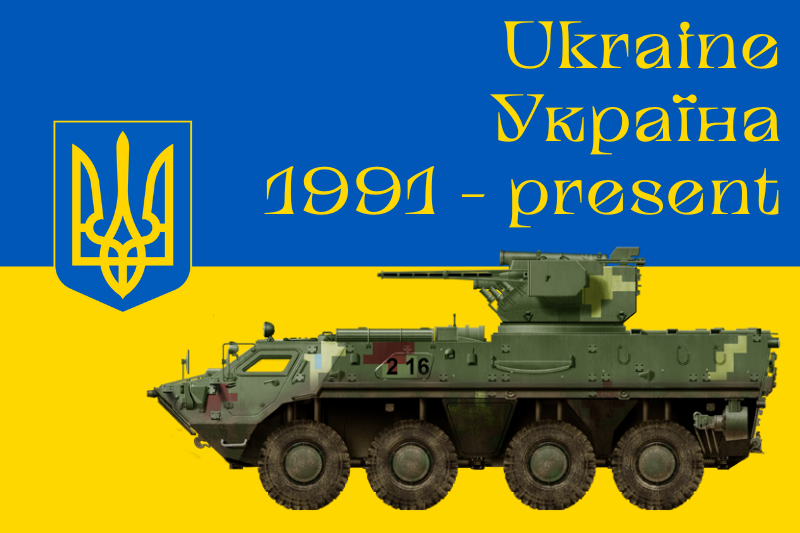Vehicles
Ukraine gained its independence from the collapsing Soviet Union in 1991, with the Soviet Republic’s Soviet declaring sovereignty in August and seeing it approved by referendum in December. The second largest Soviet Republic in population and industry, and third in size, Ukraine saw itself bordering both Russia and its Belarusian ally, to the north and east, and former Warsaw Pact countries that would quickly move to join NATO and the EU to the west. For most of its existence, Ukraine tried to maintain cordial relations with the two, handing over former Soviet nuclear weapons present in its territory to Russia in 1994. Like many other ex-Soviet states, the country struggled dramatically in the 1990s, facing an unstable economy and currency, widespread and deep-running corruption, considerable emigration, etc…
The relationship between Russia and Ukraine changed dramatically at the turn of 2013 to 2014. At this time, Ukrainian President Viktor Yanukovych, viewed as pro-Russian, abruptly canceled a popular treaty with Europe that was being worked on, instead attempting to align Ukraine closer to Russia. This led to massive protests starting in late 2013, culminating in Yanukovych fleeing to Russia in early 2014. Russia profited from the power vacuum to launch an invasion of Crimea, in which it already had a military presence, and very extensively supported Russian-speaking separatists in three oblasts of East Ukraine, Kharkiv, Donetsk, and Luhansk. The Kharkiv People’s Republic was short-lived, but Luhansk and Donetsk managed to entrench themselves, leading to a largely static war in the two oblasts after mobile warfare largely ended from 2015 onward. In the early phases of the war, the two separatists republics received not just materiel, but direct military support from Russia, with Russian artillery engaging Ukrainian troops from behind the Russian border, and occasionally entire Russian units crossing into DPR/LPR territory and engaging Ukrainian forces.
In February 2022, after months of buildup at the border, Russia announced formal recognition of the DPR and LPR, announced that it would deploy its military into the separatist Republics as peacekeepers, and then, on February 24 2022, that it would launch a “special military operation” aimed at “denazifying and demilitarizing” Ukraine. This was followed by a large offensive on the entirety of the Russian-Ukrainian border, as well as from Belarus directly towards the Russian capital of Kyiv. Though Russian troops were able to make considerable progress in the first weeks, capturing one provincial capital, Kherson, in the south, they faced much heavier resistance than expected, leading to massive losses in equipment. Russia left three northern oblasts it had launched offensives into, Kyiv, Sumy, and Chernihiv, in April 2022, before being driven out of the city of Kherson as well as the vast majority of Kharkiv Oblast in the late summer and early autumn 2022. Since then (as of February 2024), neither side has managed to achieve a major breakthrough, despite repeated attempts by Ukrainians in Zaporizhia and by Russia in various locations particularly in Donetsk. Fighting has remained very intense, with often tiny gains of land at massive costs in men and equipment.
Ukraine inherited the largest military industry in the ex-USSR outside of Russia. It also inherited considerable stockpiles of some vehicles, making Ukraine a rather large exporter of military gear. This notably included one of the few major tank plants in the USSR, the Malyshev Factory in Kharkiv. The factory has remained active and continued to develop new vehicles based on late Soviet-era designs, such as tThe T-84/Oplot/Oplot-BM tanks being a continuation of the late Cold War T-80UD, all being sub-variants of the Object 478 family. The Ukrainian military has largely standardized on the T-64BV. Despise being the oldest of the three late-Soviet MBT families, and the only one of which production was discontinued before the fall of the USSR (in 1987), the T-64 was solely manufactured by Kharkiv, and had maintenance facilities disproportionately located in Ukraine, leading to the type being particularly common there. Though less common, T-80 and T-72s have also remained in Ukrainian service. The all-out Russian invasion in 2022 significantly shook up the Ukrainian AFV fleet, with a number of Russian types, such as the T-72B3 or even T-90s captured in sometimes not insignificant number, while the country also started taking deliveries of Western AFVs, such as the Leopard 2, M1 Abrams, Challenger 2, M2 Bradley, and CV90 among many others, leading to a rather eclectic array of armor.

